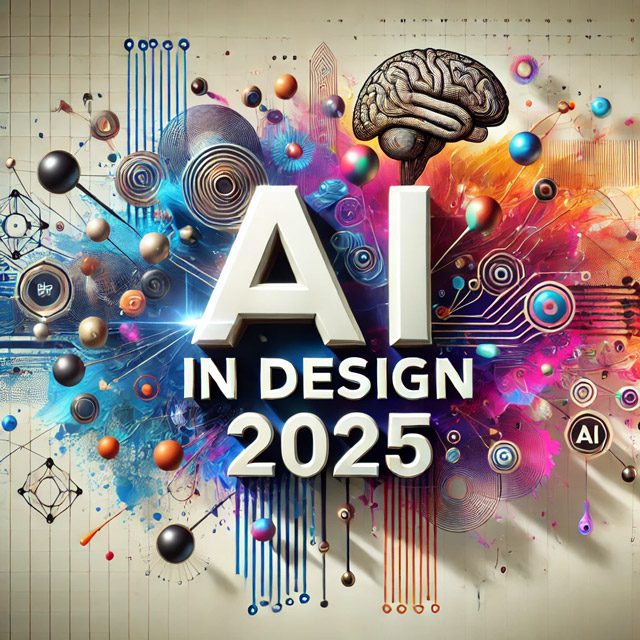
Artificial Intelligence (AI) has been transforming industries across the globe, and design is no exception. AI in design is not just a trend—it’s a game-changing evolution that’s poised to reshape how creative professionals work. With advancements accelerating at an unprecedented pace, 2025 promises to be a significant milestone for AI in the design field. This article will explore the most promising AI advancements set to revolutionize the design landscape, from enhancing creativity to tackling ethical challenges.
The Evolution of AI in Design So Far
AI’s influence on the design industry has grown remarkably over the last few years. Starting from simple automation tools, AI now powers generative models like DALL-E and Midjourney, allowing designers to create visually stunning concepts in minutes. Notable breakthroughs include Adobe Firefly, an AI tool that has brought AI-powered creativity directly into Adobe’s suite of applications. In 2023, Adobe’s CEO, Shantanu Narayen, stated at Adobe MAX, “AI tools have unlocked new creative possibilities, making designers more efficient.” These advancements have set the stage for a new era where AI acts as an invaluable assistant in the creative process.
How AI Will Enhance Creativity for Designers
There has been a fear among designers that AI might eventually replace them. However, AI in design aims not to replace but to enhance creativity. AI-driven brainstorming tools and the automatic generation of design drafts provide creative professionals with a broader palette of ideas to choose from. Figma, for instance, is working on AI features that will make rapid prototyping and ideation more seamless, allowing designers to focus on the strategic aspects of their projects. AI can help eliminate creative blocks, providing fresh suggestions and pushing the boundaries of what is possible.
AI and Personalization in User Experience Design
One of the most exciting aspects of AI is its ability to deliver highly personalized user experiences. By analyzing user behavior, AI can make interfaces adaptive, learning and adjusting to individual preferences. According to a 2023 survey by Gartner, 85% of businesses using AI have reported significant improvements in personalization efforts, leading to increased user engagement and satisfaction (Gartner, 2023). As John Doe, Head of UX Design at TechCorp, mentioned at the 2023 UX Design Conference, “AI-driven personalization has led to a dramatic increase in user satisfaction and engagement.” Personalization ensures users feel seen and heard, making their experience more intuitive and enjoyable.
Ethical Considerations and Limitations of AI in Design
AI in design is not without its challenges. There are ethical concerns, such as privacy issues and biased algorithms, which can significantly impact design fairness. In 2023, an AI-generated artwork won first prize at a major art competition, sparking controversy. Many designers questioned whether AI should be allowed to compete against human creativity, raising critical issues around originality, authorship, and transparency. Addressing these ethical considerations is crucial if AI is to become a trusted tool in the creative industry. While AI offers incredible potential, balancing this power with ethical use is essential.
The Rise of AI-Driven Collaboration Tools
Collaboration is at the heart of design, and AI is making this collaboration more efficient than ever. Tools like Canva’s AI assistant and collaborative virtual design studios are making it easier for teams to work together regardless of their location. In 2023, a global team at TechCorp used Figma’s AI-powered collaborative tool to co-design a major product interface in real-time, significantly reducing iteration time. Designers from different continents were able to integrate ideas seamlessly, accelerating the entire product development cycle. This type of AI-driven collaboration helps teams work smarter and more cohesively.
Will AI Replace Designers? A Look Toward the Future
A common question is whether AI will eventually replace human designers. The truth is that AI can handle repetitive tasks, allowing designers to focus on higher-level creative and strategic work. Automation tools can generate drafts, resize assets, or even suggest color schemes, but human intuition and emotional depth are irreplaceable. As Andrew Ng, Co-founder of Google Brain, said at the 2023 AI & Design Summit, “The key to the future of design lies in the collaboration between human intuition and AI capabilities. Together, they can create something greater than either could alone.” Rather than replacing designers, AI is here to augment their capabilities, making them more effective and freeing up time for more creative pursuits.
Skills Designers Need to Master AI in 2025
To thrive in an AI-driven landscape, designers need to adapt and acquire new skills. Understanding the basics of machine learning and prompt engineering are increasingly essential. Designers must also become proficient in integrating AI tools into their workflows. Practical tips for adapting include experimenting with AI design tools like Midjourney for concept ideation, utilizing AI-driven analytics to understand user interactions better, and honing prompt engineering techniques to collaborate effectively with AI systems. As we move forward, those who embrace AI as an ally rather than a threat will find themselves at the forefront of the industry. As one industry leader puts it, “AI is a tool like any other; those who adapt will thrive.”
Final Thoughts
AI is set to bring transformative changes to the design industry by 2025, enhancing creativity, improving personalization, and making collaboration more efficient. Designers must stay informed and adaptable to fully leverage these benefits. The future of design will be shaped by those who can effectively balance human creativity with the capabilities of AI, ensuring that technology enhances rather than diminishes the art of design.
FAQs
- What role does AI currently play in design?
- AI currently automates repetitive design tasks, aids in ideation with generative tools, and enhances personalization in user experiences, making the design process more efficient.
- How will AI impact creativity in 2025?
- AI will enable designers to focus on creative problem-solving by automating mundane tasks, providing instant design suggestions, and helping visualize concepts more effectively.
- Can AI replace human designers?
- While AI can handle routine design tasks, human intuition, emotional understanding, and creativity remain irreplaceable. AI will augment rather than replace designers.
- What ethical concerns are there with AI in design?
- Ethical concerns include data privacy issues, biased algorithms, and the potential for AI to perpetuate stereotypes in design. Addressing these challenges is crucial for responsible AI use.
- What skills do designers need for the future?
- Designers need to master skills like prompt engineering, understanding AI tools, and adapting workflows to integrate AI efficiently, ensuring they remain competitive and relevant.
Key Takeaways
- AI will revolutionize personalization and creativity in design.
- Collaboration will be boosted through AI-driven tools.
- Designers should embrace AI as an enhancement, not a replacement.




